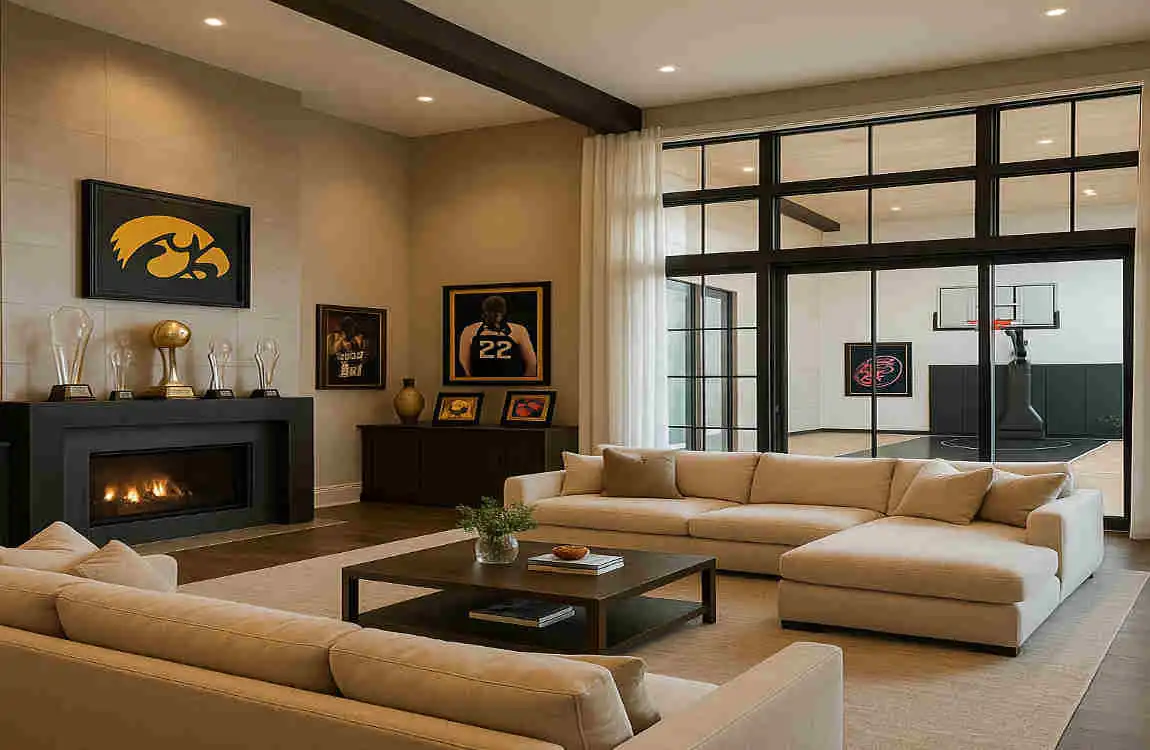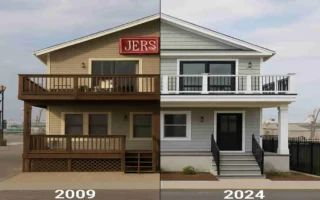Caitlin Clark has taken the basketball world by storm. From her early days in West Des Moines, Iowa, to her current status as a WNBA superstar, Clark’s journey has been nothing short of remarkable. As her fame has grown, so too has the interest in her personal life, particularly her home.
You may wonder how a house can represent someone’s career. Stick with me, and you’ll discover the unique ways Clark’s home reflects her achievements both on and off the court. From the location to the design choices, every aspect of her living spaces tells a story of dedication, hard work, and the rewards that come with it.
Who Is Caitlin Clark? The Rise to Basketball Stardom

Early Years and Breakthrough
Caitlin Clark’s love for basketball started in her hometown of West Des Moines, Iowa. Growing up, she spent countless hours honing her skills on the court, dreaming of one day playing at the highest level of the game. Her talent was evident from a young age, and she quickly made a name for herself in high school basketball.
During her time at Dowling Catholic High School, Clark led her team to multiple state championships and earned numerous accolades, including being named Iowa’s Gatorade Player of the Year. Her impressive performances caught the attention of college scouts, and she ultimately chose to attend the University of Iowa.
You may also read (why is kris jenners house considered a kardashian tv icon).
Dominance in College Basketball
At Iowa, Caitlin Clark’s star continued to rise. She shattered records and became a household name in the world of college basketball. Her scoring prowess, court vision, and leadership on the court earned her the nickname “Ponytail Pete,” a nod to her signature hairstyle and her ability to make clutch shots.
Clark’s impact on the game went beyond her achievements. She helped elevate the profile of women’s college basketball, drawing record crowds and television viewership. The “Caitlin Clark Effect” was real, and it was changing the landscape of the sport.
WNBA Success and Mainstream Recognition
In 2024, Caitlin Clark’s dream of playing in the WNBA became a reality when she was drafted first overall by the Indiana Fever. Her rookie season was nothing short of spectacular, as she quickly established herself as one of the league’s brightest stars. Clark’s performances earned her the WNBA Rookie of the Year award and helped lead the Fever to a playoff berth.
But Clark’s influence extended far beyond the basketball court. Her charisma, work ethic, and dedication to the game made her a fan favourite among both fans and the media. She landed endorsement deals with major brands and became a regular on sports talk shows and social media platforms.
The Location: Why West Des Moines and Indiana?
West Des Moines Roots
Caitlin Clark’s journey began in a modest 4-bedroom, 2.5-bath house in West Des Moines, Iowa, valued at over $650,000. This was the home where she grew up, surrounded by a supportive family and a community that nurtured her love for basketball.
Even as her fame grew, Clark remained connected to her roots. She often spoke fondly of her time in Iowa and the people who helped shape her into the person and athlete she became. Her West Des Moines home served as a reminder of where she came from and the values that guided her success.
Transition to Indiana
As Caitlin Clark’s professional career took off with the Indiana Fever, she decided to purchase a home in Indianapolis. This new residence reflected her status as a WNBA star and her commitment to her new team and city.
However, Clark didn’t abandon her Iowa roots. She maintained her home in West Des Moines, balancing her life between the two locations. This allowed her to stay connected to her family and community while embracing the new opportunities that came with her professional career.
Inside the Caitlin Clark House: Features that Mirror Her Fame

Overview of Her Homes
Caitlin Clark’s Iowa residence is a spacious 4-bedroom home that boasts a basketball hoop, a large patio, and modern amenities. The house is a testament to her love for the game and her desire to create a space where she can unwind and spend quality time with family and friends.
In Indianapolis, Clark’s home is a luxurious reflection of her professional success. The architectural highlights, high-end finishes, and athlete-focused spaces showcase her status as a WNBA star. From the moment you step inside, it’s clear that this is the home of a basketball icon.
You may also read (inside sidney crosbys stunning sewickley home).
The Basketball Influence
One of the most striking features of Caitlin Clark’s homes is the presence of in-home basketball courts and training spaces. These dedicated areas speak to her relentless drive and commitment to her craft. Even when she’s not on the court, Clark is constantly working to improve her game.
Throughout her homes, you’ll also find inspirational memorabilia, including trophies, awards, and signature items. These pieces serve as a reminder of her achievements and the hard work that got her there. They also inspire her to keep pushing forward and reaching for new heights.
Luxury and Comfort
While Caitlin Clark’s homes are undoubtedly influenced by her basketball career, they also prioritise luxury and comfort. High-end finishes, smart home technology, and areas for relaxation after games create a space where she can unwind and recharge.
Clark’s homes also feature entertaining spaces for friends, family, and teammates. These areas showcase her role as both an athlete and an entertainer, someone who loves to bring people together and create lasting memories.
The Symbolism: How the House Reflects Her Fame
From Modest Beginnings to Modern Luxury
Caitlin Clark’s journey from her family home in Iowa to her luxurious residence in Indianapolis is a powerful symbol of her rise to fame. The contrast between her early living spaces and the upgrades she has made along the way, such as a custom kitchen, a Zen garden, and an infinity pool, speaks to the success she has achieved through hard work and dedication.
These upgrades aren’t just about material possessions; they represent the milestones Clark has reached in her career. Each new addition to her home is a testament to her growth as a player and a person, and a poignant reminder of how far she has come.
The Athlete’s Sanctuary
For Caitlin Clark, her home is more than just a place to live; it’s a sanctuary where she can focus on her craft and maintain peak performance. The private gym and basketball half-court provide her with the space she needs to train and stay in top shape, even when she’s not at the arena.
But Clark’s home is also a retreat from the pressures of public life. The carefully designed zones for relaxation and reflection allow her to recharge and find balance amidst her busy schedule. It’s a place where she can be herself, away from the spotlight.
Philanthropy and Outreach
Caitlin Clark’s home isn’t just a personal space; it’s also a hub for her philanthropic efforts and community outreach. She uses her personal spaces to host charitable events and support the work of the Caitlin Clark Foundation.
Through her foundation, Clark aims to inspire and support young athletes, particularly those from underprivileged backgrounds. Her home serves as a gathering place for these efforts, a place where she can connect with the next generation and help them pursue their dreams.
How Caitlin Clark’s Home Inspires Fans and Aspiring Athletes
The “Caitlin Clark Effect” at Home
Just as Caitlin Clark has brought fans together on the basketball court, her living spaces have a similar effect. Home tours and media features showcasing her residences have captivated fans and driven even more interest in women’s basketball.
When people see the “Caitlin Clark house,” they don’t just see a beautiful home; they see the embodiment of her journey and the possibilities that come with hard work and dedication. It’s a powerful reminder of what can be achieved when you chase your dreams.
Setting Aspirational Examples
For young athletes, Caitlin Clark’s home serves as an aspirational example of what’s possible. It’s a tangible representation of how hard work and dedication can translate into real-world success.
Each feature of her home, from the basketball court to the luxury amenities, represents a milestone or achievement in her career. It’s like a vision board come to life, inspiring others to dream big and work towards their own goals.
Integrating Personal and Professional Success: Design Choices
Balancing Privacy and Public Persona
As Caitlin Clark’s fame has grown, so too does the need to balance her privacy with her public persona. The design choices in her homes reflect this delicate balance, with security features and controlled access to ensure her safety and peace of mind.
At the same time, Clark’s homes embrace her public presence, with spaces designed for entertaining and connecting with fans. It’s a testament to her ability to navigate the challenges of fame while staying true to herself.
Personal Touches and Customisation
Throughout Caitlin Clark’s homes, you’ll find personal touches and customisation that celebrate her career and her roots. Jerseys, MVP trophies, and records are proudly displayed, serving as a reminder of her achievements and the journey that got her there.
But Clark’s homes also reflect her close ties to her family and her upbringing in Iowa. Family-oriented spaces and personal mementoes create a warm and inviting atmosphere, a place where she can feel grounded and connected to her loved ones.
Media, Marketing, and the Business of Home Ownership
Media Exposure and Social Media Tours
Caitlin Clark’s homes have become a media sensation, with features on platforms like TikTok and YouTube driving the “Caitlin Clark house” phrase to the top of search trends. These tours offer fans a glimpse into her personal life, fostering a deeper connection with her as both a person and an athlete.
But the media exposure also serves a larger purpose. It helps build Clark’s brand and opens up new opportunities for partnerships and sponsorships. Her home has become an integral part of her marketing strategy, showcasing her success and her unique style.
Monetising Fame through Real Estate
As Caitlin Clark’s fame has grown, so too has the value of her homes. Celebrity-owned properties often appreciate, and Clark’s residences are no exception. Her Iowa home, valued at around $650,000, and her multi-million-dollar Indiana residence are both reflections of her growing wealth and business acumen.
However, Clark’s real estate investments extend beyond her primary residences. As she continues to build her brand and her wealth, she’s likely to explore new opportunities in the real estate market, further solidifying her status as a savvy businesswoman.
Conclusion: The Future of “Caitlin Clark House” as an Icon
Caitlin Clark’s home is more than just a place to live; it’s a true reflection of her journey from rising star to basketball legend. From her modest beginnings in Iowa to her luxurious residence in Indianapolis, every aspect of her living spaces tells a story of hard work, dedication, and the rewards that come with it.
As Clark’s career continues to soar, her home will remain a powerful symbol for fans, aspiring athletes, and the broader community. It’s a reminder of what’s possible when you chase your dreams and never give up.
You may also read (discover the secrets of kyrie irvings dream house).







